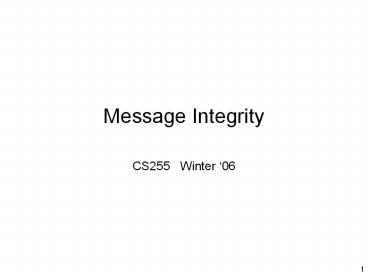Message Integrity - PowerPoint PPT Presentation
Title:
Message Integrity
Description:
Request tag for m. Get t = F(k,m) Output t as MAC forgery for the ... ask for tag on m and obtain tag on m||0. ISO: pad with '1000 00'. Add new block if needed. ... – PowerPoint PPT presentation
Number of Views:167
Avg rating:3.0/5.0
Title: Message Integrity
1
Message Integrity
- CS255 Winter 06
2
Message Integrity
- Goal provide message integrity. No
confidentiality. - ex Protecting public binaries on disk.
Protecting ads. - Requires secret key k unknown to attacker.
- Def MAC I (S,V) defined over (K,M,T) is
a pair of algorithms - S(k,m) outputs t?T ,
- V(k,m,t) outputs yes or no
k
k
Message m
tag
Alice
Bob
Generate tag tag ? S(k, m)
3
Secure MACs
- Attackers power chosen message attack.
- for m1,m2,,mq attacker is given ti ?
S(k,mi) - Attackers goal existential forgery.
- produce some new valid message/tag pair
(m,t). - (m,t) ? (m1,t1) , , (mq,tq)
- Note attacker cannot even produce a valid tag
for a nonsensical message.
4
Secure MACs
- For a MAC I(S,V) and adv. A we define a MAC
game - Def I(S,V) is a secure MAC if for all
efficient A MAC AdvA,I
PrChal. outputs 1 - is negligible.
Chal.
Adv.
k?K
b
5
Any secure PRF is a secure MAC
- Let F be a PRF over (K,X,Y). Define a MAC
IF (S,V) - S(k,m) F(k,m)
- V(k,m,t) output yes if t F(k,m) and no
otherwise. - Theorem If F is a secure PRF and 1/Y is
negligible then IF is a secure MAC. - In particular, for any MAC adversary A
attacking IF there exists a PRF adversary B
attacking F s.t. - MAC AdvA, IF ? PRF AdvB, F 1/Y
- ? IF is secure as long as Y is large, say
Y 280 .
6
Proof Sketch
- Intuition
- Adversary A issues chosen message queries m1,m2,
- Gets back F(k,m1) , F(k,m2) ,
- Must guess F(k,m) for m ? m1, m2,
- But F is a PRF, so prob A guesses F(k,m) is
1/X - Truncating MACs
- Suppose MAC is a PRF outputting n-bit tags (Y
2n). - It is OK to truncate the MAC output to wltn bits.
- as long as 1/2w is still negligible
(say w?64)
7
Examples
- AES a MAC for 16-byte messages.
- Main question how to convert Small-MAC into
a Big-MAC ? - Two main constructions
- CBC-MAC (banking ANSI X9.9, X9.19, FIPS
186-3) - HMAC (Internet protocols SSL, IPsec, SSH, )
- Both convert a small-PRF into a big-PRF.
8
Construction 1 (E) CBC-MAC
m0
m1
m3
m4
?
?
?
?
F(k,?)
F(k,?)
F(k,?)
F(k,?)
F(k1,?)
tag
Let F be PRF over (K,X,X) Define new PRF FCBC
over (K2 , XL , X )
9
CBC-MAC Analysis
- CBC-MAC Theorem For any Lgt0, If F is a
secure PRF over (K,X,X) then FCBC is a secure
PRF over (K, X?L, X). - In particular, for a q-query PRF adv. A
attacking FCBC there exists a PRF adversary B
s.t. - PRF AdvA, FCBC ? PRF AdvB, F 2 q2
Lo(1) / X - Note CBC-MAC is secure as long as q ltlt
X1/2
10
Why the last encryption step?
- Suppose we define a MAC IRAW (S,V)
where - S(k,m) RawCBC(k,m)
- Fact IRAW is easily broken using a chosen
msg attack. - Adversary works as follows
- Pick an arbitrary one-block message m?M
- Request tag for m. Get t F(k,m)
- Output t as MAC forgery for the message (m,
t?m) - Indeed RawCBC(k, (m, t?m) ) F(k, t?(t?m) )
t - Unimportant note RawCBC is secure for
prefix-free inputs.
11
CBC-MAC Padding
- What is length of m is not multiple of
block-size? - Bad idea pad m with 0s
- Vulnerable to chosen message attack
- ask for tag on m and obtain tag on m0
- ISO pad with 1000?00. Add new block if
needed. - The 1 indicates beginning of pad.
- CMAC different padding. Never adds an extra
block.
12
Construction 2 PMAC
- CBC-MAC is sequential. PMAC Parallel MAC.
m0
m1
m3
m4
?
?
?
?
F(k,?)
F(k,?)
F(k,?)
F(k,?)
?
F(k1,?)
tag
13
PMAC Analysis
- PMAC Theorem For any Lgt0, If F is a secure
PRF over (K,X,X) then FPMAC is a secure PRF
over (K, X?L, X). - In particular, for a q-query PRF adv. A
attacking FPMAC there exists a PRF adversary B
s.t. - PRF AdvA, FPMAC ? PRF AdvB, F 2 q2
L2 / X - Note PMAC is secure as long as qL ltlt
X1/2 - Note PMAC is incremental. Homework.
14
Construction 3 HMAC (Hash-MAC)
- Most widely used MAC on the Internet.
- but, we first we discuss hash function.
15
Collision Resistant Hashing
16
Collision Resistance
- Let H M ?T be a hash function.
- A collision for H is a pair m0 , m1 ? M such
that - H(m0) H(m1) and m0 ? m1
- Def A function H is collision resistant if
for all (uniform) efficient algs. A - CR AdvA,H Pr A outputs collision for
H - is negligible
- Used to have lots of examples MD5, SHA1,
- Currently, only SHA-256, SHA-512,
Whirpool - 44.5MB/sec, 11.4, 12.1
216MB/s 68
17
MACs from Collision Resistance
- Let I (S,V) be a MAC for small messages over
(K,M,T). - Let H Mbig ? M
- Define Ibig (Sbig , Vbig ) over (K,
Mbig, T) as - Sbig(k,m) S(k,H(m)) Vbig(k,m,t)
V(k,H(m),t) - Theorem If I is a secure MAC and H is
collision resistant then Ibig is a secure
MAC. - So S(k,m) AES(k, SHA-256(m)) is a secure
MAC.































